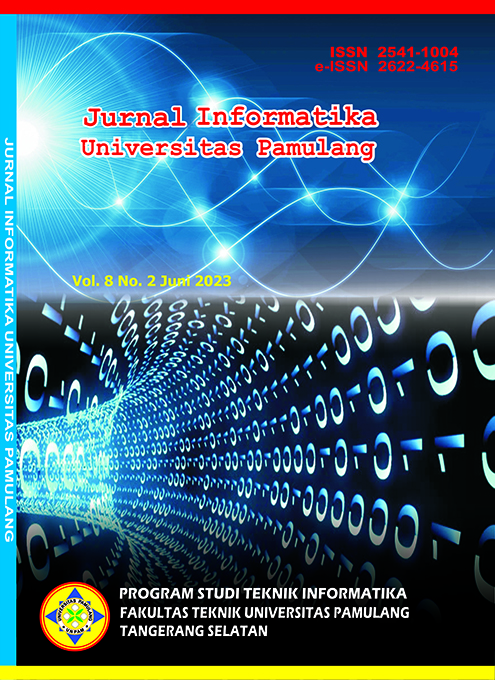Penerapan Fuzzy Backpropagation Neural Network dalam Klasifikasi Penyakit Stroke
DOI:
https://doi.org/10.32493/informatika.v8i2.31351Keywords:
fuzzy backpropagation neural network, jaringan syaraf tiruan, kecerdasan buatan, stroke.Abstract
Stroke adalah penyakit cerebrovaskuler yang ditandai dengan gejala neurologis tiba-tiba akibat cedera vaskular akut pada otak. Menurut WHO pada tahun 2019, stroke penyebab utama kematian dan kecacatan kedua di dunia, dengan prevalensi global 101,5 juta orang. Diagnosis medis penting dalam penanganan stroke, namun biaya yang tinggi sering menjadi kendala bagi masyarakat. Penelitian ini bertujuan untuk mengembangkan metode Fuzzy Backpropagation Neural Network dalam klasifikasi stroke dengan menggunakan data sekunder dari platform Kaggle yang berjumlah 4981 data. Analisis data melibatkan sepuluh variabel relevan dalam klasifikasi stroke diantaranya variabel seperti jenis kelamin, umur, hipertensi, riwayat penyakit jantung, indeks massa tubuh, nilai kadar gula dalam darah, status pernikahan, status merokok, tipe pekerjaan dan lingkungan tempat tinggal. Pada penelitian ini, pengujian yang dilakukan dibagi menjadi tiga skenario diantaranya, skenario 1 dengan α = 0,1, skenario 2 dengan α = 0,01 dan skenario 3 dengan α = 0,001 pada epoch 10, 1000 dan 100000. Hasil pengujian menunjukkan akurasi tertinggi dengan menggunakan pola jaringan 10-4-1 pada pembagian data latih dan data uji 70%:30% dengan α = 0.01 dan epoch 100000 menghasilkan tingkat akurasi sebesar 86,52%, presisi 0,87, recall 0,87 dan f-1 score 0,87. Berdasarkan hasil pengujian tersebut, FBPNN dinilai mampu dalam mengklasifikasi stroke dengan kinerja yang baik.References
Amara, M., Djamal, E. C., & Maspupah, A. (2019). Identifikasi Sinyal EEG dari Pasien Pasca-Stroke Menggunakan Backpropagation dan Algoritma Genetika. Seminar Nasional Aplikasi Teknologi Informasi (SNATi), 1907–5022.
Antares, J. (2020). Artificial Neural Network Dalam Mengidentifikasi Penyakit Stroke Menggunakan Metode Backpropagation (Studi Kasus di Klinik Apotik Madya Padang). Djtechno: Jurnal Teknologi Informasi, 1(1), 6–13. https://doi.org/10.46576/djtechno.v1i1.965
Br Sitepu, N. L. (2021). Jaringan Saraf Tiruan Memprediksi Nilai Pemelajaran Siswa Dengan Metode Backpropagation ( Studi kasus : SMP Negeri 1 Salapian). Journal of Information and Technology, 1(2), 54–58. https://doi.org/10.32938/jitu.v1i2.1006
Dritsas, E., & Trigka, M. (2022). Stroke Risk Prediction with Machine Learning Techniques. Sensors, 22(13), 1–13. https://doi.org/10.3390/s22134670
Hauriza, B., Muladi, M., & Wirawan, I. M. (2021). Prediksi Tingkat Inflasi Bulanan Indonesia Menggunakan Metode Jaringan Saraf Tiruan. Jurnal Teknologi Dan Informasi, 11(2), 152–167. https://doi.org/10.34010/jati.v11i2.4924
Muflih, G. Z. (2021). Penentuan Parameter Pembelajaran Jaringan Saraf Tiruan Backpropagation dan Pengaruhnya Terhadap Proses Pelatihan. Jurnal Riset Teknologi Informasi Dan Komputer, 1(2), 12–17. https://doi.org/10.53863/juristik.v1i02.363
Murphy, S. J., & Werring, D. J. (2020). Stroke: causes and clinical features. Medicine (United Kingdom), 48(9), 561–566. https://doi.org/10.1016/j.mpmed.2020.06.002
Permatasari, N. (2020). Perbandingan Stroke Non Hemoragik dengan Gangguan Motorik Pasien Memiliki Faktor Resiko Diabetes Melitus dan Hipertensi. Jurnal Ilmiah Kesehatan Sandi Husada, 11(1), 298–304. https://doi.org/10.35816/jiskh.v11i1.273
Prasad, P. P., Francis, F. S., & Ul Huq, S. Z. (2020). An effective fuzzy neural network with reinforcement learning approach for medical data classification. International Journal of Intelligent Engineering and Systems, 13(1), 344–353. https://doi.org/10.22266/ijies2020.0229.32
Sandy, L., Putra, A., Kusumawardhani, E., Nugraheni, P. W., Maleiva, T. N., & Gunawan, V. A. (2022). Sistem Identifikasi Dini Penyakit Stroke dengan Menggunakan Jaringan Syaraf Tiruan Perambatan Balik. Jurnal Keilmuan Dan Aplikasi Teknik Informatika, 16(2), 135–147.
Sarbaini, Cynthia, E. P., & Arifandy, M. I. (2021). Pengelompokan Diabetic Macular Edema Berbasis Citra Retina Mata Menggunakan Fuzzy Learning Vector Quantization ( FLVQ ). Jurnal Sains, Teknologi Dan Indust, 19(1), 75–80.
Setia, B., & Ramadan, A. (2019). Penerapan Logika Fuzzy pada Sistem Cerdas. Jurnal Sistem Cerdas, 2(1), 61–66. https://doi.org/10.37396/jsc.v2i1.18
Setiawan, A., Yanto, B., & Yasdomi, K. (2018). Logika Fuzzy. In Jayapungus Press Books.
Wibawa, A. P., Purnama, M. G. A., Akbar, M. F., & Dwiyanto, F. A. (2018). Metode-metode Klasifikasi. Prosiding Seminar Ilmu Komputer Dan Teknologi Informasi, 3(1), 134.
Downloads
Published
Issue
Section
License
Authors who publish with this journal agree to the following terms:
- Authors retain copyright and grant the journal right of first publication with the work simultaneously licensed under a Creative Commons Attribution-NonCommercial 4.0 International (CC BY-NC 4.0) that allows others to share the work with an acknowledgement of the work's authorship and initial publication in this journal.
- Authors are able to enter into separate, additional contractual arrangements for the non-exclusive distribution of the journal's published version of the work (e.g., post it to an institutional repository or publish it in a book), with an acknowledgement of its initial publication in this journal.
- Authors are permitted and encouraged to post their work online (e.g., in institutional repositories or on their website) prior to and during the submission process, as it can lead to productive exchanges, as well as earlier and greater citation of published work (See The Effect of Open Access).
Jurnal Informatika Universitas Pamulang have CC-BY-NC or an equivalent license as the optimal license for the publication, distribution, use, and reuse of scholarly work.
In developing strategy and setting priorities, Jurnal Informatika Universitas Pamulang recognize that free access is better than priced access, libre access is better than free access, and libre under CC-BY-NC or the equivalent is better than libre under more restrictive open licenses. We should achieve what we can when we can. We should not delay achieving free in order to achieve libre, and we should not stop with free when we can achieve libre.
Jurnal Informatika Universitas Pamulang is licensed under a Creative Commons Attribution-NonCommercial 4.0 International (CC BY-NC 4.0)
YOU ARE FREE TO:
- Share : copy and redistribute the material in any medium or format
- Adapt : remix, transform, and build upon the material for any purpose, even commercially.
- The licensor cannot revoke these freedoms as long as you follow the license terms





